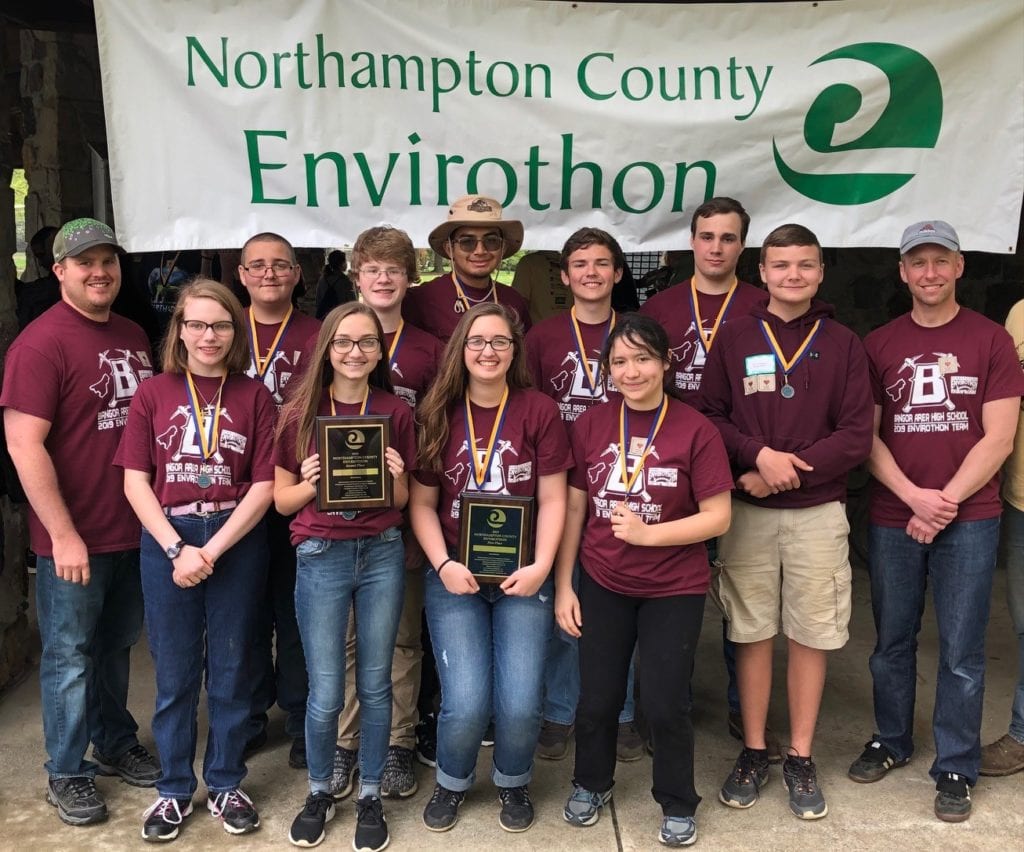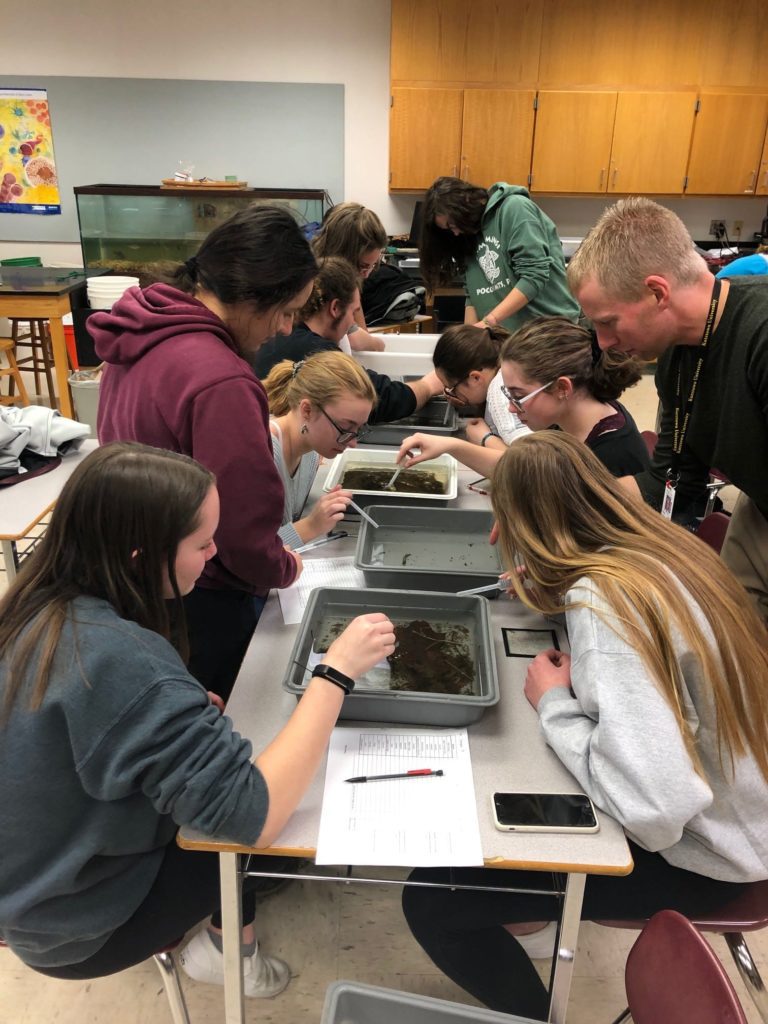One Bangor High School team has advanced to a statewide competition five years in a row – not the football, basketball, or baseball team, but the Envirothon team. This group of committed, driven students advised by science teachers Josh Thomas and Robert Hachtman takes part in Northampton County Conservation District’s Envirothon competition each year with a chance to compete at the state level if they win. Student knowledge and skills in 5 topic areas – wildlife, aquatics, forestry, soil and land use, and current issues – are examined through written and hands-on practical tests. A team of 5 high schoolers completes the Envirothon together, usually with one student specializing in each topic area.
From never having won the competition to now being on a 5 year winning streak and finishing 10th and 4th at the state level, what’s been the key to the Bangor team’s Envirothon success? Josh says “we have a great team dynamic. What started with us pushing the students, now they’re keeping themselves and each other accountable. They’re the ones driving it.” “Success has bred success,” Robert adds. Although the 2020 Envirothon was cancelled due to COVID-19, Bangor’s team will be ready when it’s safe to have the competition again.
Preparation for the competition itself begins months in advance. Although this year is different, the team typically meets with its advisors once a month, and the students drive much of the preparation outside of those meetings. Resources on testable material are released by Envirothon, and students study the information and practice practical skills. “We like to have that hands-on experience,” Robert says. “We might take the students out to measure trees with a Biltmore stick or identify invasives.” Abby Duyssen, a sophomore who joined the program last year enjoyed when the team did a stream study after school and classed, sorted, classified, and counted macroinvertebrates. “I got to learn about and handle them, which was both fun and helpful for the competition,” she says. In addition to memorizing certain pieces of knowledge and learning how to identify various species, animal tracks, soil types, and more, students prepare to respond to practical application questions. For example, when presented with a soil sample and asked to identify its composition, they might also be asked whether a location with soil of that type would be a good place for a septic system or if they would expect stormwater issues in the area. While the advisors lead hands-on activities and provide the guidance they can in monthly meetings, a significant amount of the preparation falls to the students themselves. “We provide the opportunity, but it takes a dedicated student to put in the work and make the team successful,” says Josh.
Robert and Josh have found that there is a diverse range of students interested in taking on that challenge. “Students of all levels, members of the band, students who hunt and fish, really high level academic students, all who often haven’t interacted much before are part of Envirothon,” says Josh. Students make new social connections through Envirothon, and the team benefits from having members with different backgrounds and strengths. Sarah Knitter, a junior on the team, says “the most valuable aspect of Envirothon has been, along with the learning of forestry, the friendships we create within our teams. All of us work together and help one another.” Abby echoes this sentiment. “We don’t only study for our own categories, but we read articles from each category so we can help each other during the competitions,” she says. In addition, though the team was about 80% male when they started several years ago, it has since seen a major shift in getting girls involved and is now 60-80% female. Josh and Robert think this is in part thanks to some great female leadership in the club, as well as more representation of women in STEM more broadly and other factors.
 This is particularly meaningful because Envirothon offers a great stepping stone for all students to pursue STEM careers. “We have students go into STEM-related fields at a pretty high rate,” says Josh. Robert adds, “often they come into Envirothon without a clear direction, and as they get involved they fall into that niche” and decide they want to pursue a science profession. Why is it important to have students pursue science, and specifically environmental science? “You can look at any major issue right now and there’s an environmental impact associated with it,” says Josh. “Envirothon doesn’t cover all of that, but it’s a bridge to get students interested.” Envirothon not only exposes high schoolers to environmental science topics, but also to professionals in relevant fields who supervise each station at the county and state competitions. The teachers encourage their students to ask questions of these representatives from the Game Commission, Fish and Boat Commission, Department of Environmental Protection, State Forester, and County Conservation District, among others, presenting a valuable professional development opportunity. As long as we rely on oxygen from plants, clean water to drink, and fertile soil, it’s crucial that we have members of society who understand environmental science. Envirothon encourages high school students to explore those topics, and the advisors at Bangor have helped their students make the most of that opportunity. Sarah reflects, “Envirothon has been a very rewarding experience for me, along with other members of our team. Mr. Hachtman and Mr. Thomas are always encouraging us and answering any questions we have. I think Envirothon has helped me further my passions in the scientific areas, and it’s an amazing experience.”
This is particularly meaningful because Envirothon offers a great stepping stone for all students to pursue STEM careers. “We have students go into STEM-related fields at a pretty high rate,” says Josh. Robert adds, “often they come into Envirothon without a clear direction, and as they get involved they fall into that niche” and decide they want to pursue a science profession. Why is it important to have students pursue science, and specifically environmental science? “You can look at any major issue right now and there’s an environmental impact associated with it,” says Josh. “Envirothon doesn’t cover all of that, but it’s a bridge to get students interested.” Envirothon not only exposes high schoolers to environmental science topics, but also to professionals in relevant fields who supervise each station at the county and state competitions. The teachers encourage their students to ask questions of these representatives from the Game Commission, Fish and Boat Commission, Department of Environmental Protection, State Forester, and County Conservation District, among others, presenting a valuable professional development opportunity. As long as we rely on oxygen from plants, clean water to drink, and fertile soil, it’s crucial that we have members of society who understand environmental science. Envirothon encourages high school students to explore those topics, and the advisors at Bangor have helped their students make the most of that opportunity. Sarah reflects, “Envirothon has been a very rewarding experience for me, along with other members of our team. Mr. Hachtman and Mr. Thomas are always encouraging us and answering any questions we have. I think Envirothon has helped me further my passions in the scientific areas, and it’s an amazing experience.”
Photos provided by Mr. Josh Thomas.

